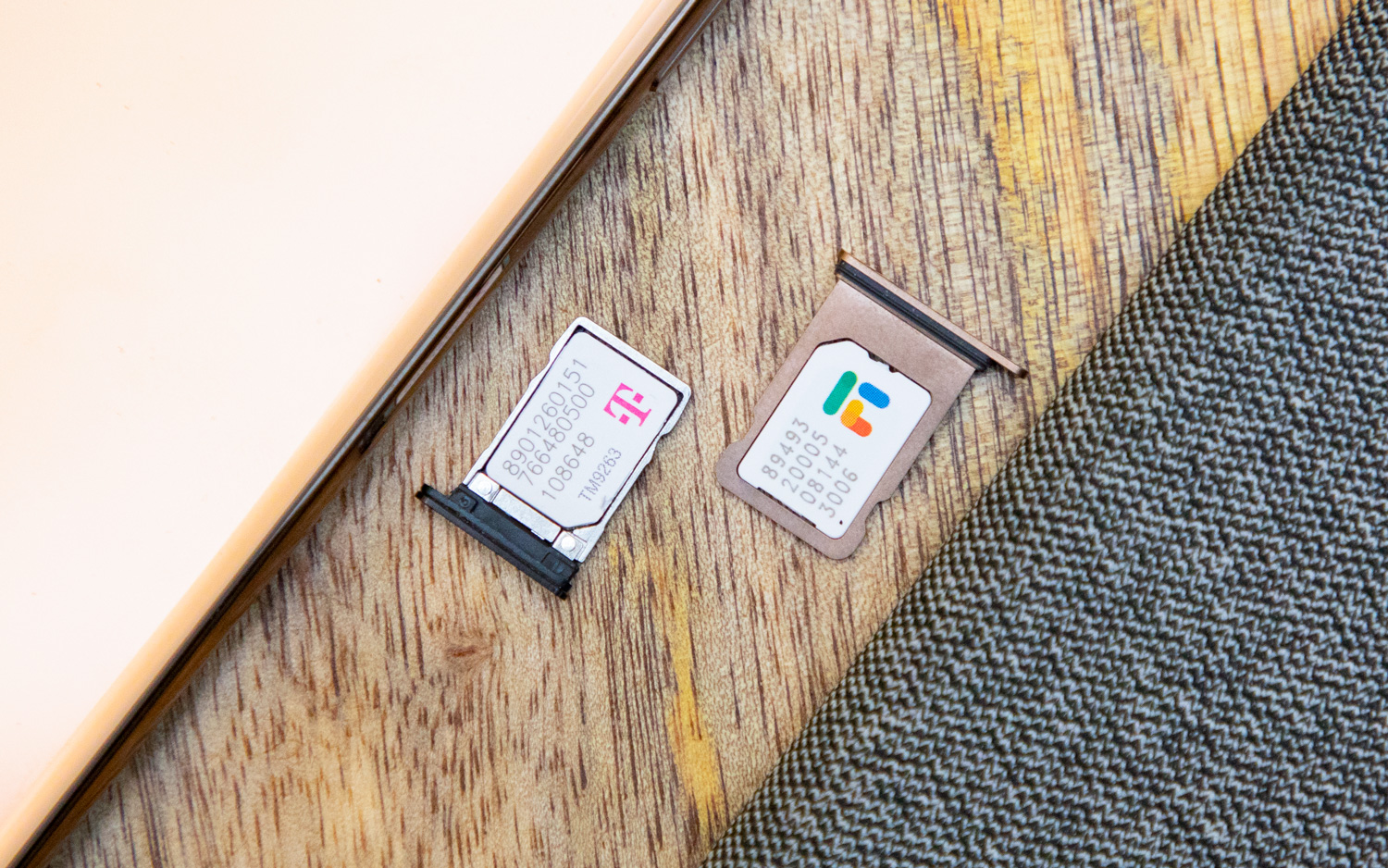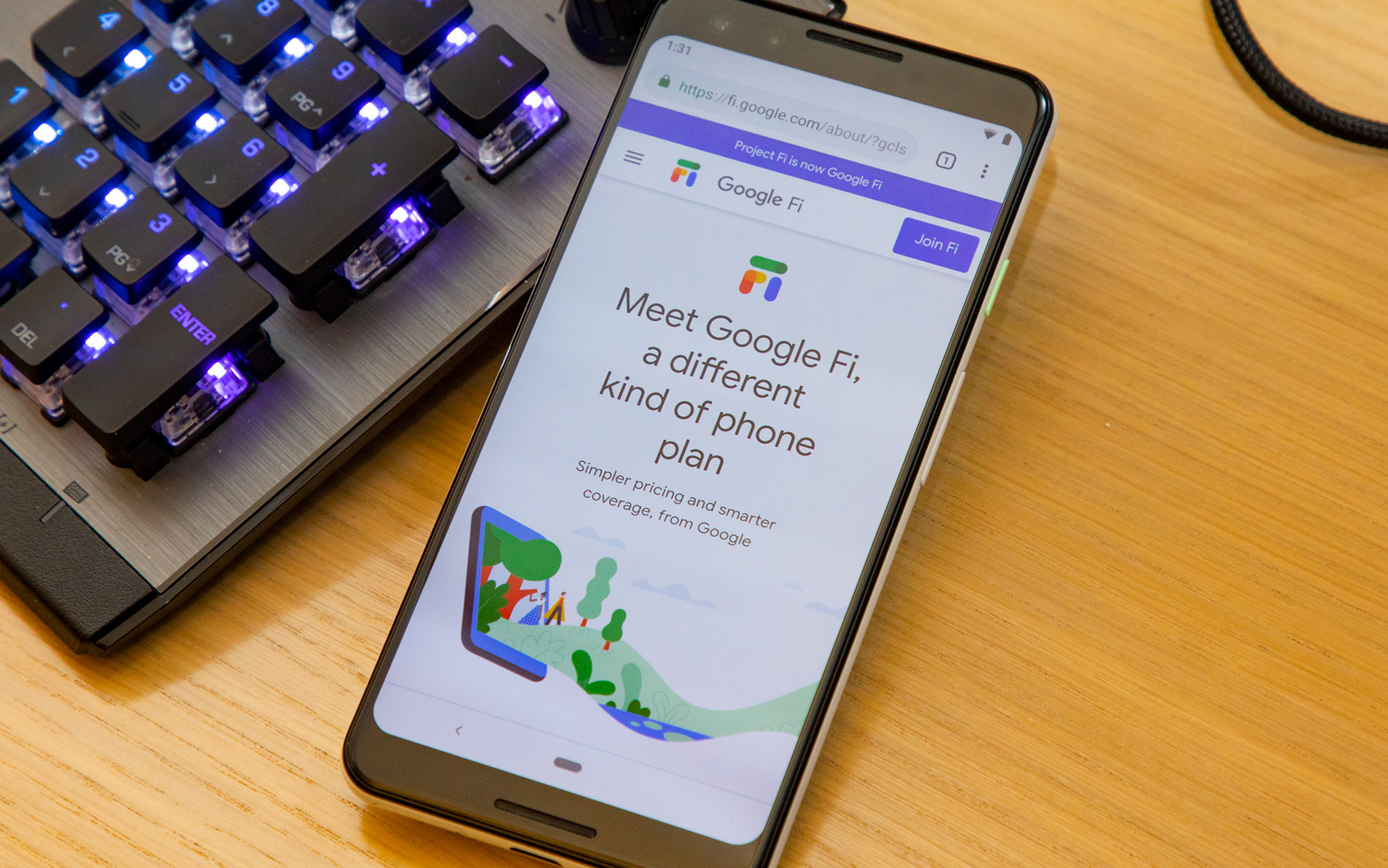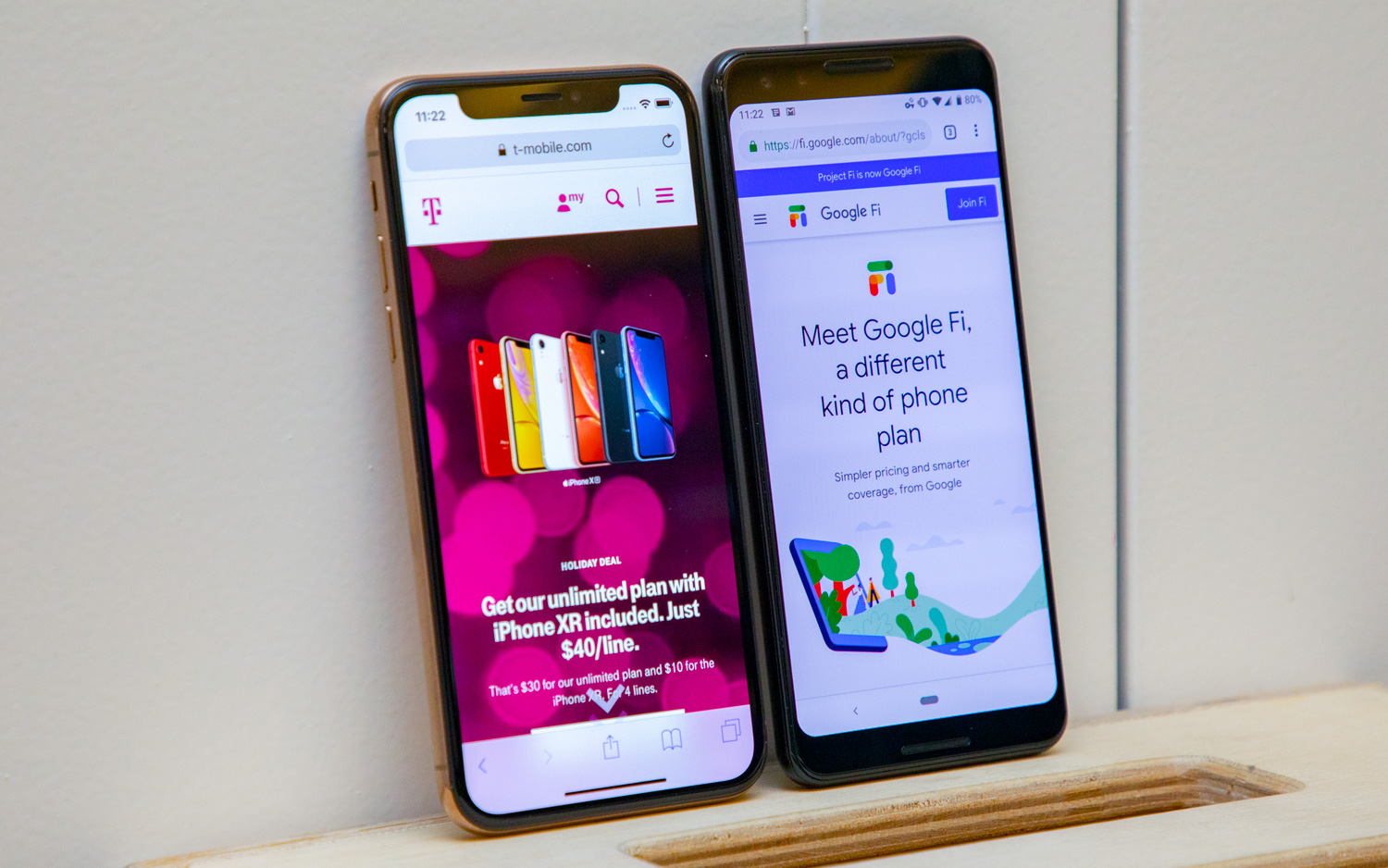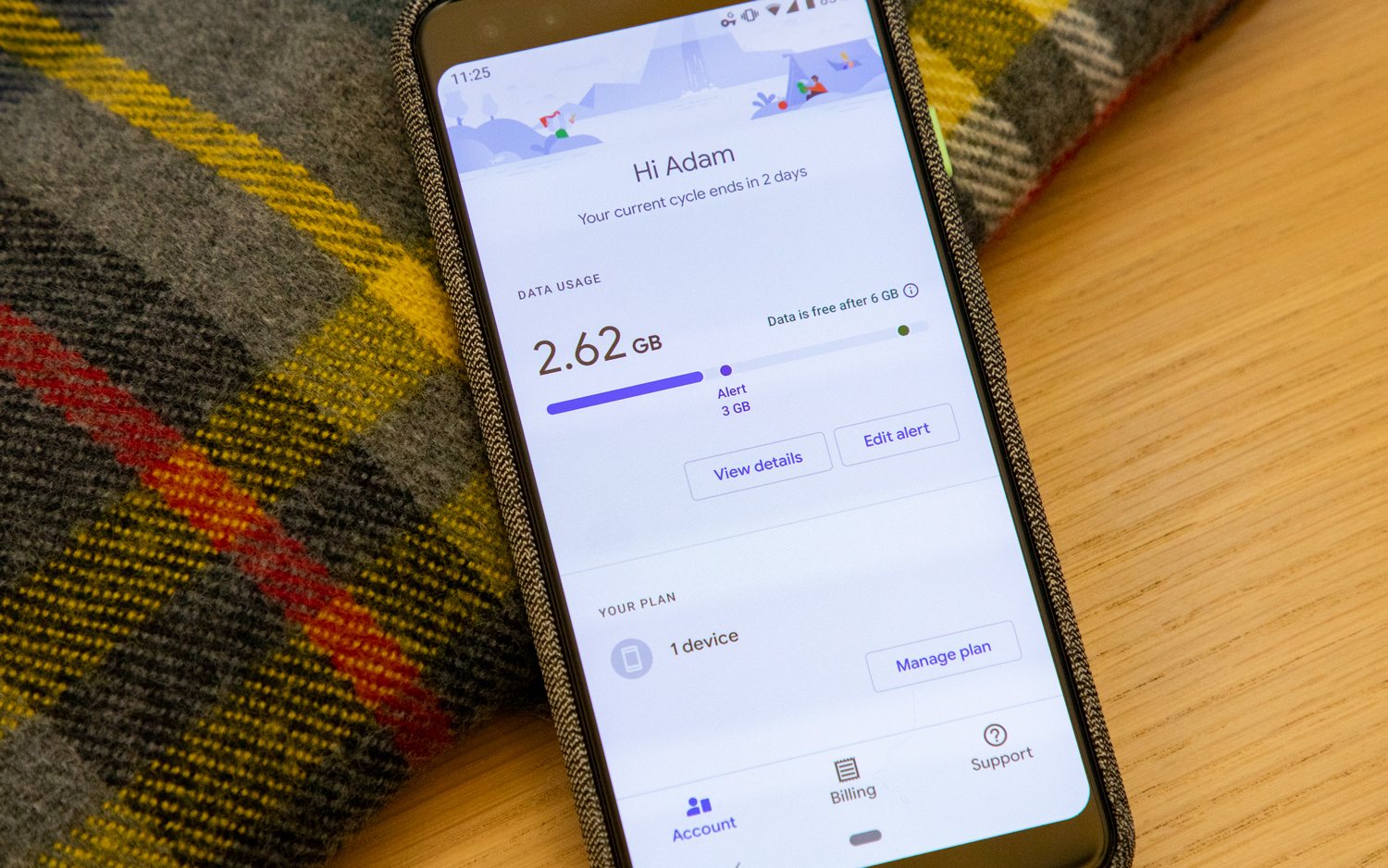Google Fi vs. T-Mobile: Which Is a Better Deal?
Google Fi is a new kind of wireless carrier that deviates from the pack, but T-Mobile offers the most competitive plans and perks among the big four networks. Here's how they stack up.

T-Mobile is one of our favorite wireless carriers, thanks to its competitive unlimited plans and laundry list of customer perks. Google Fi is an up-and-coming wireless service that offers some compelling benefits of its own, like excellent international coverage and pay-what-you-use pricing.
With Fi's latest update, Google's opened the carrier up to nearly all unlocked phones — finally making it a viable consideration for anyone searching for a better deal on their wireless bill. Fi even partly uses T-Mobile's network to deliver service.
However, both T-Mobile and Google Fi are quite different, once you look past their similar coverage maps. Because of their unique pricing models, one carrier is likely a better fit for you depending on your needs and use cases. In this face-off, we'll compare the pros and cons of each service to help you make an informed decision.
Google Fi's Key Strengths
- Pay only for the data you use
- Intelligent network switching (on select devices)
- Free VPN service for all web traffic
- Seamless international service
T-Mobile's Key Strengths
- Best unlimited plan
- Greater selection of phones to choose from
- Excellent perks
Coverage
T-Mobile has made considerable gains in recent years regarding expanding coverage. The Uncarrier is now second only to Verizon in nationwide LTE access, according to WhistleOut, blanketing 59 percent of the country compared with Verizon’s 70 percent. However, it dropped to third among all eight carriers Tom's Guide tested in this year’s quest to find the U.S.' fastest network speeds, behind both Verizon and AT&T.
T-Mobile also happens to be the primary network Google Fi uses to deliver its wireless service, and the speeds Google's customers achieve are no different than what T-Mobile's postpaid subscribers do. We say "primary" because Google Fi actually incorporates three different networks for its total coverage map: T-Mobile, Sprint and regional carrier U.S. Cellular.

Any ordinary unlocked phone you bring to Google Fi will only connect to T-Mobile's towers. However, if you buy a Pixel 3, Pixel 2 or one of the Fi-optimized handsets Google offers through the Fi store, those devices have the capability to connect to all three networks and are designed to seamlessly switch to the fastest among them at any given time.
Because Fi comprises T-Mobile's and Sprint's towers in one network, you could argue its coverage map is technically larger, albeit only if you're using one of those special handsets that can take advantage of all three of Fi's networks. There may be areas where Sprint has more of a presence than T-Mobile — a situation that actually came into play in our carrier testing this year, when the Now Network proved fastest in Philadelphia. Sprint topped the Uncarrier with an average download speed of 43.2 Mbps to T-Mobile's 26.2 Mbps.
Sign up to get the BEST of Tom's Guide direct to your inbox.
Get instant access to breaking news, the hottest reviews, great deals and helpful tips.
MORE: My Month With Google Fi: Why I'm Sticking With It
Fi also leverages Google's 2 million free public hotspots worldwide to offer VPN-protected, unmetered data. A Fi-optimized phone will connect to these hotspots seamlessly, and notify you when it does. However, having used Fi extensively in New York City, we've found these hotspots aren't prevalent enough to help you save on your monthly bill in any substantial way. Additionally, they're only available to customers who opt for handsets optimized for Fi (the Pixels and a handful of others from Moto and LG).
Plans
For individuals: Google Fi offers only one pricing structure, where users pay $20 for the first line and $15 for each additional line thereafter, and $10 per gigabyte shared between all devices on the account. If you're a single line user who consumes 3GB of data in one month, you can expect to pay $50 at the end of your billing cycle, plus taxes and fees. Every 100MB adds another $1, so Google won't round you up to the next gigabyte if you cross a certain point.
However, that all changes once you use more than 6GB on Google Fi. In that event, a feature called Bill Protection kicks in, which prevents you from being charged for any additional data used. At that point, you can think of it as an unlimited plan — although Google deprioritizes your data if you exceed more than 15GB. By comparison, the point at which T-Mobile begins throttling on its unlimited plans is 50GB.
Google Fi vs. T-Mobile: Unlimited Plans
| Plan | Cost | Notes |
| Google Fi | $80 | Bill Protection caps bill at $80 no matter how much data used; speeds throttled after 15GB |
| T-Mobile Essentials | $60 | Includes $5 credit for Auto Pay enrollment; video streaming capped at 480p; unlimited hotspot data capped at 3G; limited international coverage; speeds can be throttled at any point, and furthermore after 50GB |
| T-Mobile One | $70 (taxes and fees included) | Includes $5 credit for Auto Pay enrollment; video streaming capped at 480p; unlimited hotspot data capped at 3G; speeds throttled after 50GB |
| T-Mobile One Plus | $85 (taxes and fees included) | Includes $5 credit for Auto Pay enrollment; video streaming capped at 1080p; includes 20GB of LTE hotspot data; speeds throttled after 50GB |
Comparatively speaking, T-Mobile's unlimited plans are a better value. The base Essentials plan costs $60 and is ideal for those who rarely or never travel out of the country, though T-Mobile reserves the right to slow data for Essentials subscribers at any time. Select the $70 One plan, which includes taxes and fees, and you'll get better overseas coverage and full LTE speeds until you hit 50GB. The only significant downside to One is that its caps mobile video streaming to 480p.
Bump yourself up to the $85 One Plus plan, and you’ll get full-HD streaming and faster data abroad, as well as 20GB of hotspot data at LTE speed (on lower plans, throughput is unlimited, but restricted to 3G pace).
MORE: Google Fi vs. Verizon: Which Is Right for You?
T-Mobile also offers prepaid plans — an unlimited option at $50 per month and another that grants you 10GB for $40. Neither bakes in taxes and fees like the postpaid One plans do, though the 10GB offering is a great value compared to what Fi gives you — Google would charge you twice as much for that amount of data.
For families: As with most other carriers, both T-Mobile and Google Fi start handing out per line discounts for every user that joins you on your plan. Two lines on a T-Mobile One plan cuts the price to $60 each ($120 total), down from $70, and adds a free Netflix subscription for good measure. There's currently a promotion going on that reduces three lines down to $40 a piece (also $120), while four lines breaks them down further to $35 ($140).
When that promotional pricing isn't in place, T-Mobile family plans cost $70 for the first line of T-Mobile One, $50 for line two, and $20 for each line after that. That means a family of four normally pays $160 a month for T-Mobile One.
Google Fi vs. T-Mobile: Plans for Families
| Carrier/Plan | Single Line Cost | 2 Lines Cost | 3 Lines Cost | 4 Lines Cost |
| Google Fi | $60 for 4GB ($20 line access + $40 for 4GB) | $115 for 8GB ($35 line access + $80 for 8GB) | $150 for 10GB ($50 line access + $100 for 10GB) | $185 for 12GB total ($65 line access + $120 for 12GB) |
| T-Mobile One | $70 (with Auto Pay enabled; includes taxes and fees) | $120 (with Auto Pay enabled; includes taxes and fees) | $140 (with Auto Pay enabled; includes taxes and fees) | $160 (with Auto Pay enabled; includes taxes and fees) |
| T-Mobile Simply Prepaid | $40 | $70 | $100 | $130 |
If you're interested in the perks the One Plus add-on grants you, those can be tacked onto each line individually for $15, or $10 if you decide to buy it for both users on a two-line account.
On Google Fi, every line after the first costs $15 instead of $20, and shares the same pool of data. However, the point at which Bill Protection kicks in changes as you add more lines. It's raised to 10GB for two users, and increases by 2GB for every additional user after that.
Phones
T-Mobile's phone offerings run the gamut from the latest iPhones and Samsung Galaxy handsets to the OnePlus 6T. In fact, the Uncarrier is the only U.S. wireless provider that sells the 6T on contract. And because it's a GSM-based network, T-Mobile is widely compatible with most unlocked phones in a way that rival carriers Verizon and Sprint aren't.
MORE: Best Smartphones: Here Are the 10 Best Phones Available
Google Fi also now works with most unlocked phones, though again, handsets that are brought to the network and not sold by the carrier will not support all of Fi's features, like switching between the three networks. In terms of devices that are optimized for Fi, you have your choice between the Pixel 3 and 3 XL, the Pixel 2 and 2 XL, the Moto G6, Moto X4 Android One, LG G7 ThinQ and LG V35 ThinQ.
Customer service
We were pleased with T-Mobile’s customer service when we evaluated it last year. Representatives were forthcoming on social media, over the phone and through the carrier's web-based chat platform — although the language they used to dispense advice wasn't always clear. And since then, T-Mobile has launched a revamped Team of Experts program that guarantees you'll talk to a real person when you need help with your phone.

If there's one concern with T-Mobile, it's that the carrier's website doesn't clearly explain the differences between its plans. For example, T-Mobile doesn't offer a checklist that stacks all of its One unlimited plans side by side, so you can better understand the differences between them. The details for every plan tend to be concealed in massive blocks of fine print that gloss over things like Auto Pay, which is typically required to get the prices advertised on the site.
Conversely, Google Fi's simpler, more self-explanatory pricing structure leaves less room for confusion. Any change you need to make to your account can be done through the Google Fi app, which is available on both iOS and Android. It's definitely the slickest carrier app we've ever encountered, which isn't surprising given that Google built it. It also offers quick links to all the network’s support channels, as well as estimated wait times listed on screen before you call.
Extras and perks
Google Fi isn't a carrier that offers many perks for its customers, though the two notable advantages of the service — free VPN routing for all web traffic and excellent international coverage — differentiate it from other mobile virtual network operators. The VPN feature is only supported by Fi-optimized phones, however.
Fi's international coverage spans more than 170 countries and costs the same abroad as it does at home. Roaming data is still charged at the standard $10-per-gigabyte rate, which isn't something many carriers offer. Additionally, Fi users can snag up to nine data-only SIM cards for free, which can be put in other connected devices, like tablets and laptops. Traffic using a data-only SIM adds to your monthly data totals, but doesn't tack on any extra rate or line access fees.

T-Mobile, on the other hand, leads the pack in extras for its customers. There's Netflix On Us, which includes a standard, two-device Netflix subscription with One postpaid plans that cover two or more lines. T-Mobile Tuesdays serves up discounts and promotions on a weekly basis, slashing prices on everything from Lyft rides to free phone giveaways and trips to live events and sports.
T-Mobile Digits lets customers use their number on other connected devices, for an additional monthly cost. That's a nice convenience, though T-Mobile's international coverage ultimately isn't as appealing as Google Fi's. T-Mobile's service works in more than 210 countries for One and One Plus subscribers, and you have unlimited texting when traveling. But data is throttled at 2G speed in those 210 countries — which is near unusable in this day and age.
Bottom line
Although they're quite different, Google Fi and T-Mobile boast their share of advantages. Google Fi offers a premium wireless experience that can tap three networks (provided you own the right phone), as well as VPN access and fantastic international coverage. However, T-Mobile's unlimited and prepaid offerings are considerably less expensive and postpaid customers get a world of perks and access to the industry's best phones on contract.
For most people, that makes T-Mobile the safer bet. However, Pixel users would be wise to give Fi a look, especially if they're frequent travelers.
Adam Ismail is a staff writer at Jalopnik and previously worked on Tom's Guide covering smartphones, car tech and gaming. His love for all things mobile began with the original Motorola Droid; since then he’s owned a variety of Android and iOS-powered handsets, refusing to stay loyal to one platform. His work has also appeared on Digital Trends and GTPlanet. When he’s not fiddling with the latest devices, he’s at an indie pop show, recording a podcast or playing Sega Dreamcast.
-
gianchaz To be clear re: Project Fi costs: You show $60 for 4GB ($20 line access + $40 for 4GB). If I use just 2G of data, I receive a $20 credit. If I had purchased 8G and used 4.5G, I receive $35 Credit.Reply
Also keep in mind, there is no minimum GB purchase. Fi will add on as you use it up to the Bill Protection for for your plan.. So, if I purchased 1GB and used 1.8 GB, I'd be charged $20 for 2GB minus $2.00 for unused portion.
This is Cellular Data -
markowenweiner Google Fi ( previously Project Fi) has been around for several years..I wouldn't say it's an upcoming new product.... We normally get a $ credit for unused data every month. When I switched to Project Fi more than two years ago... I saved about $1,000 per year over my old TMobile plan...of course things change over time.. new plans... get what works best for you.... I like paying for only what we actually use.Reply
What's the point of paying for unlimited data if you don't actually need or use it... money left on the table..
Google customer service is excellent... They are there 24/7 to assist you in any way.... and are good listeners. I had a problem with a phone I purchased... they refunded the entire thing and enabled me to use that to purchase a replacement .... I purchased a Pixel 2 and couldn't be happier... amazing camera... -
ryanfiereck I appreciate the effort by Tom's guide. But these plans are not comparable it is apples to oranges. You need to run this guide with Google fi high at 1 gig and 2 gig levels to see the comparables. You don't sign up for Google fi and treat it like it's an unlimited service that would be downright indescribable. I had high hopes for this article only to come and find out it was a letdown. why don't you run a guide for individuals who want to only use 1 2 3 and 4 gigs per month and see who the comparables are that would be worth some significant research.Reply -
gianchaz Keep in mind what prior posters stated.Reply
Google's base Price is $20 with no starting charge for data. Imagine: if you used no data then it's $20+tax.Use a half gig, it's $25.
I save about $70/mo vs a Verizon plan I previously had. The first year's savings easily covered the cost for my Pixel I.
Must agree on Customer Service. Easy to contact, easy to work with. -
mrowe122007 No no no, no. 50 plus taxes for 3gb of use? My apps probably use a GB a month just in updates and I don't even have that many apps. I pay 60 at metro and get unlimited data, hotspot, included with a Amazon prime membership, Android one. Flat 60 a month with metro using my own device. I don't care what anyone says you can't beat itReply -
gianchaz Reply21580446 said:No no no, no. 50 plus taxes for 3gb of use? My apps probably use a GB a month just in updates and I don't even have that many apps. I pay 60 at metro and get unlimited data, hotspot, included with a Amazon prime membership, Android one. Flat 60 a month with metro using my own device. I don't care what anyone says you can't beat it
Question: No access to WiFi? I do all updates via WiFi. I only sync via WiFi, too.
As always, choose the Plan that fits your needs best.
-
mickisdaddy Also with Google Fi they automatically connect you to open WiFi networks while you are out and about while still using their VPN. Our bills for to lines run about $65 a month.Reply
